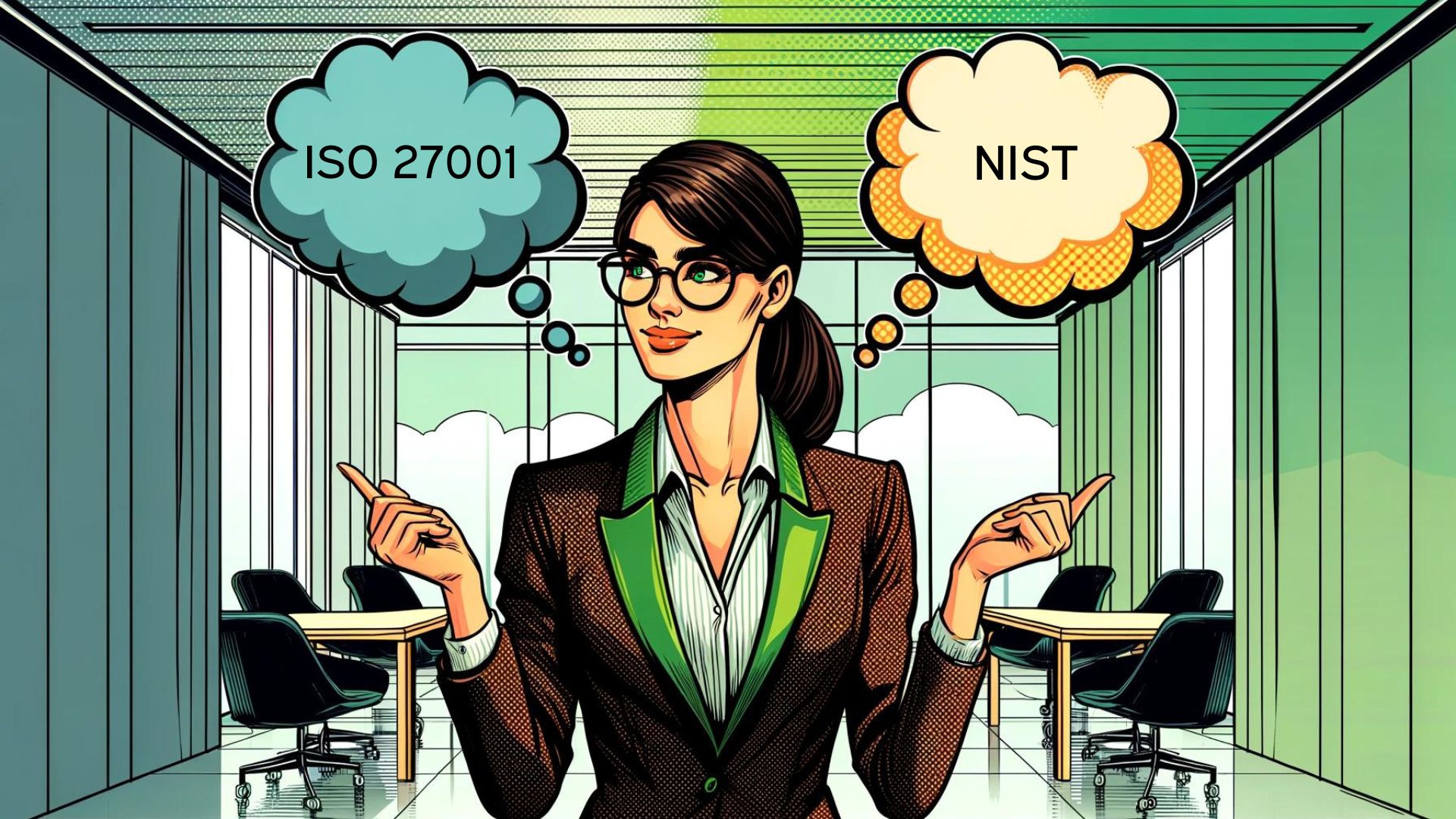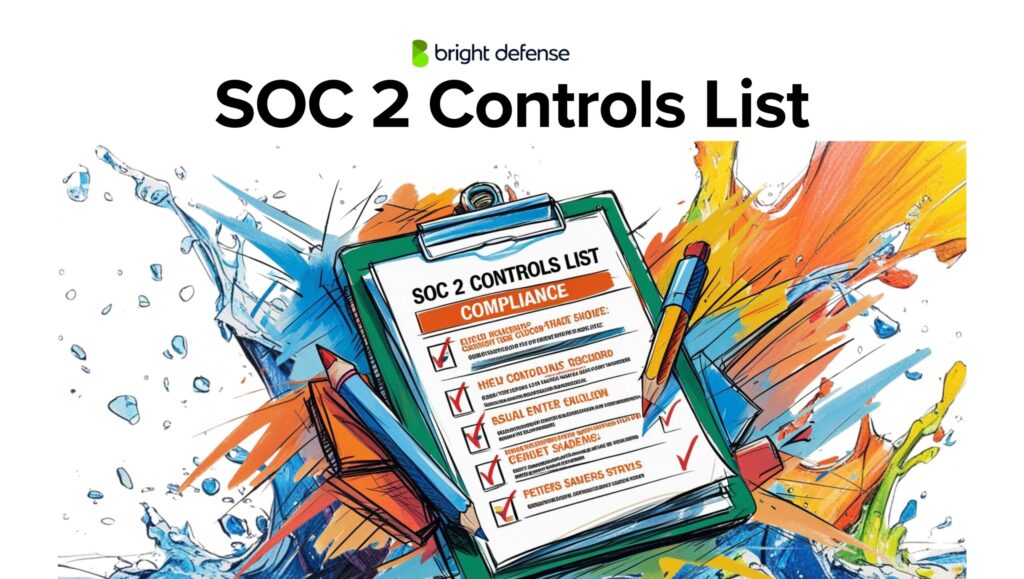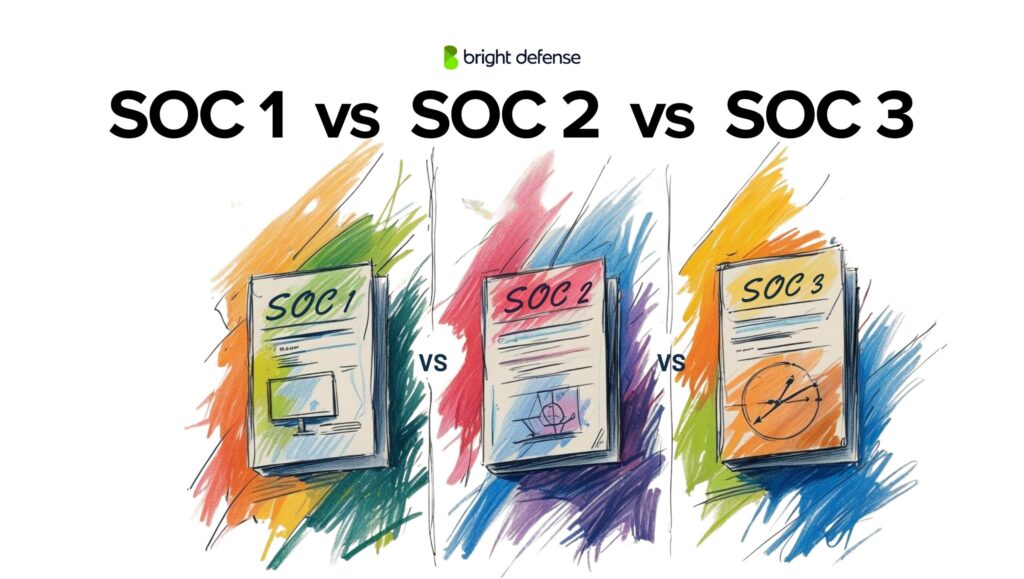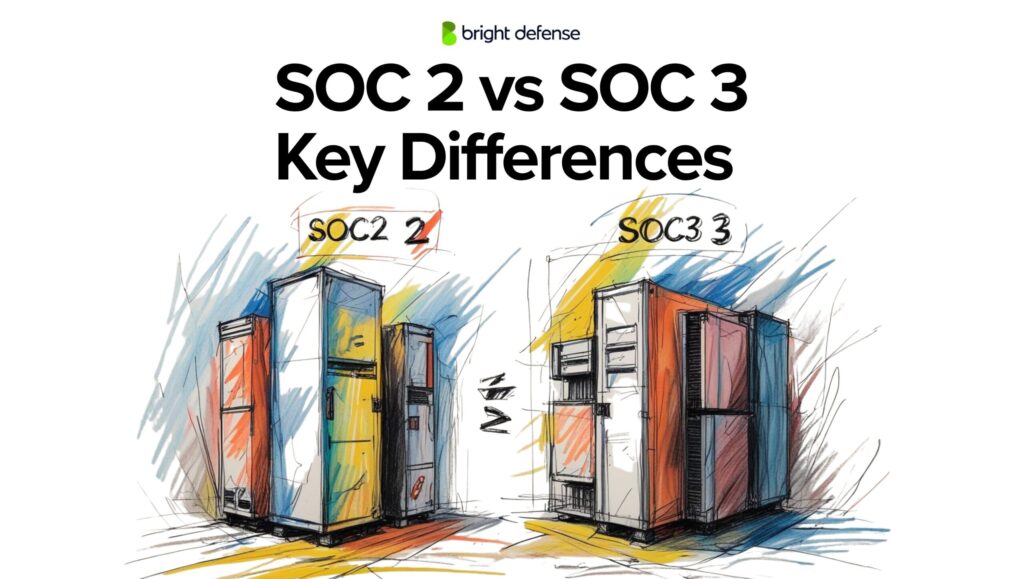
John Minnix - Compliance Strategist
June 28, 2025
ISO 27001 vs. NIST: Choosing the Right Framework
Across the globe, organizations are ramping up efforts to protect their data from cyber threats. Cybersecurity compliance frameworks are useful for structuring a cybersecurity program and developing a security-conscious culture. ISO 27001 vs. NIST is a common comparison for organizations choosing a cybersecurity framework.
ISO 27001 is a comprehensive international standard that provides a blueprint for organizations to establish, implement, maintain, and continually improve an Information Security Management System (ISMS). It is structured and detailed, ideal for organizations that need clear guidance on every aspect of security management.
On the other hand, the NIST Cybersecurity Framework offers a set of voluntary guidelines, best practices, and standards to help organizations manage cybersecurity risks. The framework is adaptable, making it suitable for customization according to specific organizational needs and risk profiles.
Understanding these frameworks is key to determining which might be more appropriate for your organization. The goal of this article is to help you better understand each framework and pick which is right for you.
ISO 27001: An Overview
ISO 27001 is a comprehensive framework for managing information security. Developed by the International Organization for Standardization (ISO) and the International Electrotechnical Commission (IEC), it provides a systematic approach to managing sensitive company information.
ISO 27001 encompasses IT security, human resources, physical security, and business continuity. It sets criteria for the establishment, implementation, maintenance, and continuous improvement of information security management systems (ISMS). It offers a systematic approach to managing sensitive data to ensure confidentiality, integrity, and availability.
Origin and Development: ISO 27001 originated from the British Standard 7799, published in 1995. It was later adopted as an international standard in 2005. It has been revised regularly to adapt to the changing information security landscape.
Key Objectives and Scope: The primary objective of ISO 27001 is to help organizations establish and maintain an ISMS. An ISMS incorporates all legal, physical, and technical controls involved in an organization’s information risk management processes. Organizations are required to pass an audit in the first year. Surveillance audits are conducted in the next two years, followed by a recertification audit in the third year.
Main Components:
- Risk Assessment and Treatment: Identification, evaluation, and implementation of measures to manage and mitigate risks.
- Control Selection: Implementing a comprehensive set of information security controls, or other forms of risk treatment (such as risk avoidance or risk transfer).
- Performance Evaluation: Regularly checking the performance and effectiveness of the ISMS.
Certification Process: Organizations must undergo a rigorous audit by an accredited certification body to ensure compliance with the standard. Once certified, the organization is required to undertake regular reviews and internal audits, as well as complete a three-year re-certification audit.

NIST Cybersecurity Framework: An Overview
The NIST Cybersecurity Framework was developed by the National Institute of Standards and Technology. It provides businesses with a structured and flexible framework for managing cybersecurity risk. Originally intended for critical infrastructure operators, the framework has gained broad acceptance across various sectors due to its adaptability.
Background and Development: NIST was created in response to growing cybersecurity threats and a presidential executive order aimed at improving the cybersecurity of critical infrastructure. Released in 2014, it has been embraced by organizations globally to address and manage cybersecurity risks. It is notably adopted by federal agencies, underscoring its critical role in the U.S. government’s efforts to manage cybersecurity risks.
Its use remains voluntary for private sector organizations. However, rules such as the Cybersecurity Maturity Model Certification (CMMC) will require private sector companies to meet NIST 800-171 standards to receive federal funding. Other state initiatives, such as Texas’s TX-RAMP framework, are following suit.
Core Objectives and Scope: NIST’s core is to enhance the cybersecurity posture of an organization through a set of industry standards and best practices. It aims to help organizations manage cybersecurity risks in a cohesive manner, focusing on the protection of privacy.
Key Elements:
- Identify, Protect, Detect, Respond, Recover: These five functions offer a high-level strategic view of an organization’s management of cybersecurity risk.
- Implementation Tiers: These provide context on how an organization views cybersecurity risk and the processes in place to manage that risk.
- Profiles: Profiles help organizations align their cybersecurity activities with their business requirements, risk tolerances, and resources.
Implementation Tiers and Profiles: NIST encourages customization of its implementation. Organizations assess their current practices against the desired outcomes and prioritize gaps in their practices to achieve their target state.

ISO 27001 vs. NIST: A Comparative Analysis
Comparing ISO 27001 vs. NIST reveals aspects of each that organizations should consider when choosing the right framework for their cybersecurity needs. This section provides a detailed analysis of both frameworks.
Scope and Application:
ISO 27001 is designed to help organizations of any size and industry around the world secure their information systems. It guides you in creating an Information Security Management System (ISMS).
NIST Cybersecurity Framework is like a flexible toolkit. It offers guidelines that any organization can adapt to improve their cybersecurity measures—whether they’re small businesses or large corporations. It is particularly popular in the U.S. among industries like utilities, government, and healthcare.
Compliance and Certification:
ISO 27001 involves a formal checkup, where an external and independent auditor looks at your security setup to see if it meets the standard’s strict requirements. Passing this audit results in certification, which is recognized worldwide and often needed to satisfy business or regulatory requirements. The audit process is based on a three year cycle, with a larger audit in year one, and min-audits in years two and three.
NIST Cybersecurity Framework, on the other hand, doesn’t require any formal certification. It’s more like a voluntary guide that helps organizations measure their own cybersecurity health and fix gaps. It’s about continually getting better at protecting against and responding to cyber threats, without the pressure of passing a formal audit.
Some compliance frameworks that are based on NIST include FedRAMP, StateRAMP, and CMMC. These may require an audit or self-assessment to achieve compliance.
Approach to Risk Management:
ISO 27001 is all about being proactive. It requires you to perform detailed risk assessments to understand what specific threats your organization faces. Then, you choose and apply security measures specifically designed to handle those risks. ISO 27001 isn’t a one-time thing. It’s an ongoing process that keeps evolving as new threats and vulnerabilities are discovered.
NIST Cybersecurity Framework encourages you to match your cybersecurity efforts with the specific risks and needs of your business. It introduces a tiered system to help you understand how mature your cybersecurity practices are, and provides a pathway to improve over time. This framework is very much about tailoring your cybersecurity practices to be as efficient and effective as possible based on your unique business environment and the specific risks you face.
Both frameworks aim to make you safer from cyber threats but approach it in slightly different ways. ISO 27001 might be more suitable for organizations that need stringent security measures recognized globally, while the NIST Framework could be better for those looking for flexibility and continuous improvement in their cybersecurity practices.
Strengths and Weaknesses:
- Strengths of ISO 27001 include its comprehensive scope, international recognition, and the rigor of its certification process, which can enhance an organization’s reputation.
- Weaknesses include its potentially high implementation cost and the complexity of maintaining certification.
- Strengths of the NIST Framework include its adaptability, ease of implementation, and its effectiveness in improving an organization’s cybersecurity maturity.
- Weaknesses include the lack of a formal certification process, which might be a drawback for organizations needing to prove compliance to external parties.
Industry Adoption:
ISO 27001: Global Adoption and Impact
ISO 27001 is embraced by organizations around the world, from multinational corporations to non-profit entities. This is largely because of its structured certification process and international recognition. The certification is particularly valued in industries where protecting information is critical, such as finance, healthcare, and IT services. As ISO 27001 is recognized internationally, it facilitates business relationships and contracts where data security and compliance are mandated.
NIST Cybersecurity Framework: Adoption in the U.S.
The NIST Cybersecurity Framework, on the other hand, is particularly popular in the United States. This is especially true among government agencies and critical infrastructure sectors. NISTs widespread adoption is driven by its alignment with national security priorities.
Unlike ISO 27001, which focuses on compliance and certification, the NIST Framework emphasizes continuous improvement and risk management. This makes it a dynamic tool for enhancing cybersecurity resilience.
Choosing Between ISO 27001 and NIST CSF:
- ISO 27001 is better suited for companies needing to demonstrate compliance with a recognized security benchmark, particularly in competitive or international markets. It is also preferred where a comprehensive approach to all types of information is necessary.
- NIST Cybersecurity Framework is ideal for organizations looking for flexibility to adapt to their specific conditions and those aligned with U.S. federal operations. It is also more cost-effective, making it accessible for startups and smaller companies.
Cost Analysis: ISO 27001 vs. NIST
Adding a cost dimension to the comparative analysis between ISO 27001 and the NIST Cybersecurity Framework is crucial for organizations to understand the financial implications of adopting either or both frameworks.
ISO 27001 Costs
ISO 27001 involves a more formal certification process, which can be quite costly. These costs include:
- Initial Assessment and Implementation: This phase involves setting up the Information Security Management System (ISMS), which can require significant investment in technology, training, and manpower. Depending on the size and complexity of the organization, this can range from $5,000 to $100,000 or more.
- Certification Audit: Conducted by an accredited auditor, this cost varies based on the organization’s size and scope but typically ranges from $5,000 to $30,000 for the audit alone.
- Maintenance and Recertification: To maintain certification, organizations must undergo regular audits and continually improve their ISMS, adding ongoing costs that can be similar to initial audit fees every three years, plus any costs for internal staff or external consultants to manage the ISMS.
NIST Cybersecurity Framework Costs
The NIST Cybersecurity Framework is voluntary and does not require formal certification, which can significantly reduce direct costs. However, indirect costs should be considered:
- Implementation Costs: While there is no certification cost, the implementation involves integrating the framework into current practices, which might require technology investments, training, and possibly hiring additional staff or consultants. This can range widely, from a few thousand dollars to tens of thousands, depending on the depth and breadth of the implementation.
- Continuous Improvement: Since the framework emphasizes ongoing improvement, organizations may incur costs related to regular risk assessments, upgrading technologies, and training staff. These are variable and depend on the specific activities undertaken.
Bright Defense offers cost effective solutions to achieve ISO 27001 and NIST compliance tailored to meet the budgets of small and medium businesses. Contact Bright Defense for pricing to achieve your desired framework.

Combining ISO 27001 and NIST
Merging ISO 27001 and the NIST can give your organization a well-rounded strategy to handle cybersecurity threats effectively. This section looks at how to integrate these frameworks and what benefits they might bring when used together.
Comprehensive Cybersecurity Management: Integrating ISO 27001 and NIST can create a complete security management plan. While ISO 27001 provides a clear roadmap to building and maintaining an information security management system, NIST offers adaptable guidelines that help address and manage cybersecurity risks broadly. Together, they ensure that your security efforts are both comprehensive and adaptable to changes in the threat landscape or business requirements.
Benefits of Using Both Frameworks Together:
- Enhanced Coverage: Combining these frameworks allows you to cover all bases—ISO 27001’s stringent controls and certification process ensure detailed security measures are in place, while NIST’s flexibility allows you to adapt quickly to new or evolving risks.
- Streamlined Compliance: With both frameworks in play, your organization can meet diverse regulatory requirements more efficiently. This dual framework approach is particularly useful for organizations operating across different geographical locations, each with its own compliance demands.
- Robust Risk Management: By integrating the detailed risk assessment process of ISO 27001 with the broader risk management strategies of the NIST Framework, your organization can achieve a deeper and more dynamic understanding of its security risks.
Exploring the Feasibility of Multiple Compliance Frameworks
Integrating these frameworks is not only beneficial but also entirely feasible. Many organizations successfully adopt a dual-framework strategy by aligning ISO 27001’s specific controls with the overarching goals of the NIST Framework. This approach requires initial planning and ongoing adjustment to ensure that the frameworks complement rather than complicate each other’s processes.
By adopting both ISO 27001 and the NIST Cybersecurity Framework, organizations can ensure they are not just compliant, but also resilient and responsive to the rapidly changing cyber threat environment. This comprehensive approach is a proactive way to safeguard sensitive data and systems, enhancing overall business continuity and security.

Conclusion
Choosing between NIST vs. ISO 27001 boils down to what your organization needs. Here’s a simple take:
ISO 27001 offers a global, structured way to manage all aspects of information security, not just digital but also physical and staffing security. It’s perfect for companies that need to prove they meet international standards.
NIST Cybersecurity Framework, on the other hand, is more flexible. It’s great for any size company in the U.S., adapting easily as your company grows and as technology changes. It focuses on continuously getting better at handling cybersecurity threats.
Combining the two could give you the best of both worlds: ISO 27001’s thorough standards and the adaptability of the NIST Framework. This mix can make your cybersecurity stronger by covering a wider range of risks and compliance needs. Ultimately, the decision should be based on a detailed look at what your organization specifically needs to protect itself from cyber threats.
Bright Defense Delivers ISO 27001 and NIST Compliance!
If you are considering ISO 27001 or NIST compliance frameworks, Bright Defense can help. Our mission is to protect our customers from cybersecurity threats through continuous compliance. Our monthly engagement model simplifies the compliance process and delivers a robust cybersecurity program to meet compliance frameworks including IS0 27001, NIST, SOC 2, HIPAA, PCI, and more.
All of our service plans include our compliance automation platform. Compliance automation helps increase efficiency and lower the cost of compliance. Additional services include vCISO, security awareness training, mobile device management, and more.
Get started on your compliance journey today. Stay secure with Bright Defense!
Get In Touch



